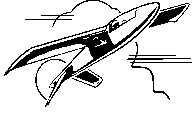What is TPG?
TPG is an abbreviation for Taylor
Paper-Glass. In 1978, Molt watched his associate Jerry Holcomb using
TopFlite MonoKote™ as a covering for his sheeted R/C models. Molt noticed that
the covering created a structure that was much stronger than traditional
methods. With the increasing cost of aircraft plywood and aluminum, Molt found
that many potential experimental airplane builders have felt discouraged due to
increasing costs, and concern about their ability to perform the manufacturing
operations required to build a metal airplane. After contacting various paper
manufacturers in the Pacific Northwest, where he lived, Molt hit upon a very
common paper product called “Solid Fiber Boxboard” which is readily
available and lends itself to the concept. The basic idea of the process is to
laminate a very strong material on both sides of the relatively low cost paper
“core” material to obtain a strong, rigid, composite SANDWICH structure that
is inexpensive and lightweight. The construction technique also eliminates the
need for expensive tooling. Only simple wooden formers are required.
The paper is an un-bleached “Kraft” paper which is light
tan in color and comes in a wide variety of thickness. The two thickness most appropriate for use in the TPG process are “90 pound Linerboard” which
is about 0.025” thick and “Laminated Solid Fiberboard” which is about
0.050” thick.
It was apparent to Molt at that time that GFRP (glass fiber
reinforced plastic) i.e. “fiberglass” and polyester resin would serve the
purpose at the least cost. Accordingly, after considerable experimentation, Molt
and Jerry settled on a tightly woven, plain-weave, glass cloth designated as #
1528 or 7528 which is available from many glass cloth weavers and suppliers.
The resin used was “Koppers Dion 6692T Fire Retardant Resin”.
It is a polyester resin. It was chosen for its reasonable physical properties,
and cost.
While these are the materials chosen by Molt, the method is
applicable to other materials. The use of other cloths and different resins can
be considered, but since TPG is very much an experimental material for which
specific strength allowables are not available, each piece must be built and
tested to at least 2 times the calculated design load. TPG is EXPERIMENTAL
!!
Why Use TPG?
In a nutshell, Cost and Workability. The basic materials are
quite inexpensive, and is easy to work with and form to the desired shapes.
Think of TPG as being a lot like aircraft plywood and you’ll get the idea. The
thinner “Linerboard” material can be shaped into simple curved shapes and
can be used as a substitute for sheet metal or plywood in areas such as ribs,
shear webs, and some larger components. The thicker “Laminated Solid
Fiberboard ” can be used for flat pieces such as structural bulkheads, and for
gently curved components. It can be curved sharply, by the “scoring” method.
It is not practical or possible to make compound curved pieces from a single
piece TPG just as it is not practical to do so with plywood. TPG is
EXPERIMENTAL !!
How To Do It
Parts are drawn out on the paper core using felt-tip markers
and ordinary drafting tools. The paper is then cut to shape along the layout
marks with a utility knife and scissors. The paper core is placed in the formers
(if any), “sealed” with resin and allowed to cure. The part is then “glassed”
on one side or the other with the required number of ply's and orientation of the
reinforcing cloth. After cure, the part can be removed from the tooling fixture
and the opposite side can receive its structural plays of reinforcing cloth. It
is the reinforcing cloth that gives TPG its strength, the paper itself can best
be thought of as a stable core material which is essentially self supporting on
which to lay up the structural cloth. Pieces of TPG can be joined together by
bonding and by the use of mechanical fasteners such as rivets, staples and bolts
The Book
It is not practical to cover the entire process here. Jerry
Holcomb has written the “instruction manual” for the TPG process which can
be purchased from him. Contact him for information at:
Jerry Holcomb
1010 N.E. 122nd Avenue
Vancouver, WA. 98664
 Mini-IMP
Aircraft Company
Mini-IMP
Aircraft Company .htm_cmp_expeditn000_bnr.gif)